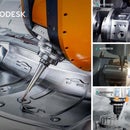Introduction: Relief Creation
This lesson outlines how to create and work with basic relief shapes.
Note: All files can be found at the bottom of each lesson. Feel free to save the files to your own directory.
Step 1: Example 5-1
Step 2: Anchor Tutorial
- Open Model anchor.art
- Shape Editor – large top bar
- Flat Plane with Start Height of 0.5 mm (0.02”) – Add & Apply
- Hide Zero Plane
- Shape Editor – 2 inner top bar
vectors
- Round at 45º, with Start Height of 0 – Add & Apply
- Shape Editor - main anchorvector
- Square at 65º, with Limit to Height 0.75mm (0.03”) - Merge High & Apply
- Shape Editor – two hookvectors
- Round at 30º, with Start Height of 0.75mm (0.03”) - Merge High & Apply
- Shape Editor - two Circle
vectors
- Round at 65º, with Start Height of 0.5 mm (0.02”) - Merge High, Apply & Cancel
- Toggle Vector Visibility off
The Vectors are hidden, and the final result can be seen.

Attachments
Step 3: Bitmap Motif Tutorial


- Open BitmapMotif.art
- Switch to 3D View
- Toggle on Display Bitmap icon from the 3D View
toolbar


- Double click on the colour blue to make it the primary colour
- Open the Shape Editor
- Choose a Round shape with an angle of 30 degrees
- Enter in a Start Height of 1mm (0.05”)
- Check Scale To Height and type in a Height of 3.5mm (0.15”)
- Click Apply
- Double click on the colour green to make
it the primary colour
- Choose a Round shape with an angle of 30 degrees
- Enter in a Start Height of 1.5mm (0.1”)
- Click Apply

- Double click on the colour red to make
it the primary colour
- Choose a Round shape with an angle of 40 degrees
- Enter in a Start Height of 2mm (0.1”)
- Check Limit To Height and type in a Height of 2mm (0.1”)
- Click Apply and Cancel
- Select Display Material
 to toggle back to the Relief (material) view.
to toggle back to the Relief (material) view.
- Select Smooth Relief
 from the Relief Editing
Toolbar
from the Relief Editing
Toolbar
- Set the Strength to 20% and click Apply
- Toggle Zero plane
 from
the 3D view Toolbar to view the results.
from
the 3D view Toolbar to view the results.

Step 4: Mountain Scene Tutorial
This tutorial will cover the main features of the “Free Relief Modelling” concept. The entire example will be done directly in the 3D view.Create a New Model600mm x 600mm (24”x24”), resolution 2500 x 2500.
- Toggle on Vector Visibility in the 3D View.
- Open the Relief Clipart Library and drag Mountains1 from the Greenery folder into the model, place this on the right hand side of the model.
- Drag Mountains2 from the Greenery folder into the model, place this on the left hand side of the model.
- Move each piece of clipart into a position as shown below and make sure they are blending into each other nicely.

- Drag TreeLine from the Greenery folder into the model, place this on the right hand side of the model, just below the mountains as shown below.

- Exit the transform tool and left mouse select the clipart of the TreeLine.
- Open the Mirror Objects tool and ensure Copy the original objects ticked and then select Across model. This will make a mirrored copy of the TreeLine clipart.
- Move the original TreeLine clipart to the left so it does not look symmetrical to the other tree line.

- Select all of the clipart and either open the transform tool and paste or press enter on the keyboard to paste the clipart into the model.
- If it created vector outlines, select and delete them.
Clipart can also be loaded in by dragging a relief file into ArtCAM.
- Using Windows Explorer (My Computer) Navigate to the ArtCAM Data Files.
- Find Cloud.rlf from this tutorial and manually drag into ArtCAM’s 3D view.
- Using Transform, move the cloud to the top left of the model and resize the width to approximately 400mm (16”).
- Unlink the Z Range and change the value to 1mm (0.05”), Apply.

- Select this cloud and copy it to the right by holding down the left mouse button and Ctrl on the keyboard whilst dragging the cloud to the right side of the model.
- Open the Transform tool for this new cloud (if not already open) and rotate it by approx 180°by clicking outside the model and moving the mouse to rotate. Move into position as shown below.

- Select all blue clipart and paste into the model by pressing Enter.
- Delete any vector boundaries.
- Open the Relief Clipart Library (if it is not already open) and click on Wolf from the Animals section.

- Select this wolf and copy it to the right by holding down the left mouse button and Ctrl on the keyboard whilst dragging it to the right side of the model.
- Using Transform, manually mirror the new wolf by dragging the right side midpoint, over it-self to the left, as shown below.

- Ensure the Z Range is unlinked back on the Transform page and Scale the wolf down about 50%.
- Position the wolf near the tree line on the right side.
- Select the Relief
Clipart PasteOptions page from within the
Transform menu
 .
.
- Add a Height of 2.5mm(0.1”) and click Paste.

- Select and paste the other wolf.

- Open the Relief Clipart Library and select the Custom Reliefs Library.
- From the Project Tree on the right hand side, drag the Front Relief and drop it into the relief library panel.
- Right click on the new clipart and Rename it to Wolf Mountain Scene.














